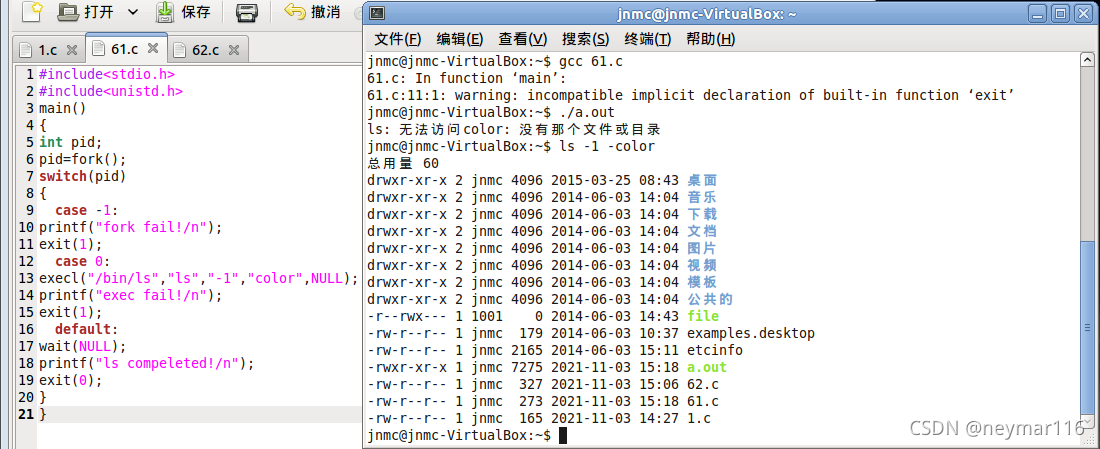实验六:进程控制
实验目的:
- 巩固进程创建的知识
- 掌握wait()、sleep()等调用的功能及基本的使用方法。
- 了解exec()系统调用的基本知识
实验内容:
- 用fork( )创建一个进程,再调用exec( )用新的程序替换该子进程的内容
- 利用wait( )来控制进程执行顺序
- 使用sleep()系统调用,让子进程“睡眠”10秒钟
实验资料:
- exec( )系列
在Linux中,并不存在一个exec()的函数形式,exec指的是一组函数,一共有6个,分别是:
#include
int execl(const char *path, const char *arg, ...);
int execlp(const char *file, const char *arg, ...);
int execle(const char *path, const char *arg, ..., char *const envp[]);
int execv(const char *path, char *const argv[]);
int execvp(const char *file, char *const argv[]);
int execve(const char *path, char *const argv[], char *const envp[]);
exec函数族的作用是根据指定的文件名找到可执行文件,并用它来取代调用进程的内容,换句话说,就是在调用进程内部执行一个可执行文件。
- wait()系统调用:
原型:
#include<sys/types.h>
#include<sys/wait.h>
Pid_t wait(int *status)
等待子进程运行结束。如果子进程没有完成,父进程一直等待。wait( )将调用进程挂起,直至其子进程因暂停或终止而发来软中断信号为止。
参数可以是NULL此时父进程对于这个子进程是如何死掉的不关心,仅仅是想把子进程彻底的消灭掉。
- sleep()函数调用
原型:#include<unistd.h>
Unsigned int sleep(unsigned int seconds)
该函数调用使进程挂起指定的秒数。
- exit()
终止进程的执行。
系统调用格式:
void exit(status)
int status;
为了及时回收进程所占用的资源并减少父进程的干预,利用exit( )来实现进程的自我终止,通常父进程在创建子进程时,应在进程的末尾安排一条exit( ),使子进程自我终止。exit(0)表示进程正常终止,exit(1)表示进程运行有错,异常终止。
参考程序
1.
#include<stdio.h>
#include<unistd.h>
main( )
{
int pid;
pid=fork( ); /*创建子进程*/
switch(pid)
{
case -1: /*创建失败*/
printf("fork fail!\n");
exit(1);
case 0: /*创建了一个子进程*/
execl("/bin/ls","ls","-1","-color",NULL);
printf("exec fail!\n");
exit(1);
default: /*父进程*/
wait(NULL); /*同步*/
printf("ls completed !\n");
exit(0);
}
}运行结果
执行命令ls -l -color ,(按倒序)列出当前目录下所有文件和子目录;
ls completed!

分析原因
程序在调用fork( )建立一个子进程后,马上调用wait( ),使父进程在子进程结束之前,一直处于睡眠状态。子进程用exec( )装入命令ls ,exec( )后,子进程的代码被ls的代码取代,这时子进程的PC指向ls的第1条语句,开始执行ls的命令代码。
2.
#include<sys/types.h>
#include<sys/wait.h>
#include<unistd.h>
#include<stdlib.h>
main()
{
pid_t pc,pr;
pc=fork();
if(pc<0)
printf(“creat error\n”);
else if(pc==0){
printf(“this is child process with pid of %d\n”,getpid());
sleep(10);
}
else{
pr=wait(NULL);
printf(“I catch a child process with pid of%d\n”,pr);
}
exit(0);
}
